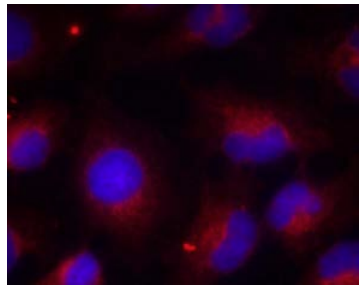Anti-PTEN (Phospho-Ser380) Antibody (43009)
Data
- -
- -
Antibody DetailsProduct DetailsReactivity Species Human ⋅ Mouse ⋅ Rat Host Species Rabbit Immunogen Peptide sequence that includes phosphorylation site of Serine 380 derived from human PTEN and conjugated to KLH. Product Concentration 1.0 mg/ml Formulation PBS (without Mg2 and Ca2 ), pH 7.4, 150mM NaCl, 0.02% sodium azide and 50% glycerol. State of Matter Liquid Product Preparation Affinity-purified on phosphopeptide; non-phosphopeptidereactive antibodies were removed by chromatography on non-phosphorylated peptide Storage and Handling This antibody is stable for at least one (1) year at -20°C. Country of Origin USA Shipping Next Day 2-8°C Applications and Recommended Usage? Quality Tested by Leinco Immunofluorescence: use at dilution of 1:100- 1:200.
Immunohistochemistry: use at dilution of 1:50- 1:100. These are recommended working dilutions. End user should determine optimal dilutions for their applications. Each investigator should determine their own optimal working dilution for specific applications. See directions on lot specific datasheets, as information may periodically change. DescriptionSpecificity Rabbit Polyclonal Antibody specific to PTEN (Phospho-Ser380) Background Phosphatase and tensin homolog (PTEN) was identified as a tumor suppressor that is mutated in many cancers. PTEN is a phosphatidylinositol-3,4,5-trisphosphate 3-phosphatase. It contains a tensin-like domain as well as a catalytic domain similar to the dual specificity protein tyrosine phosphatases. Unlike most protein tyrosine phosphatases, PTEN preferentially dephosphorylates phosphoinositide substrates. It negatively regulates intracellular levels of phosphatidylinositol- 3,4,5-trisphosphate in cells and functions as a tumor suppressor by negatively regulating Akt/PKB signaling pathway. Antigen DetailsFunction Tumor suppressor. Acts as a dual-specificity protein phosphatase, dephosphorylating tyrosine-, serine- and threonine-phosphorylated proteins. Also acts as a lipid phosphatase, removing the phosphate in the D3 position of the inositol ring from phosphatidylinositol 3,4,5-trisphosphate, phosphatidylinositol 3,4-diphosphate, phosphatidylinositol 3-phosphate and inositol 1,3,4,5-tetrakisphosphate with order of substrate preference in vitro PtdIns(3,4,5)P3 > PtdIns(3,4)P2 > PtdIns3P > Ins(1,3,4,5)P4 (PubMed:26504226, PubMed:16824732). The lipid phosphatase activity is critical for its tumor suppressor function. Antagonizes the PI3K-AKT/PKB signaling pathway by dephosphorylating phosphoinositides and thereby modulating cell cycle progression and cell survival. The unphosphorylated form cooperates with MAGI2 to suppress AKT1 activation. Dephosphorylates tyrosine-phosphorylated focal adhesion kinase and inhibits cell migration and integrin-mediated cell spreading and focal adhesion formation. Plays a role as a key modulator of the AKT-mTOR signaling pathway controlling the tempo of the process of newborn neurons integration during adult neurogenesis, including correct neuron positioning, dendritic development and synapse formation. May be a negative regulator of insulin signaling and glucose metabolism in adipose tissue. The nuclear monoubiquitinated form possesses greater apoptotic potential, whereas the cytoplasmic nonubiquitinated form induces less tumor suppressive ability. In motile cells, suppresses the formation of lateral pseudopods and thereby promotes cell polarization and directed movement. {PubMed:16824732, PubMed:26504226}.; [Isoform alpha]: Functional kinase, like isoform 1 it antagonizes the PI3K-AKT/PKB signaling pathway. Plays a role in mitochondrial energetic metabolism by promoting COX activity and ATP production, via collaboration with isoform 1 in increasing protein levels of PINK1. NCBI Gene Bank ID UniProt.org Research Area Phosphospecific Antibodies References & Citations |




